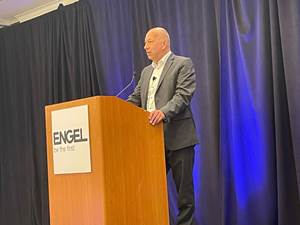2013: Another Strong Year for Automotive
Wood on Plastics
It will be the fourth consecutive year of solid growth, bringing total assemblies to just half a million units shy of their pre-recession level of about 12 million units per year
Our latest forecast calls for total motor vehicle assemblies in the U.S. to reach 11.5 million units in 2013, representing an 11% rise over 2012. Last year’s 10.3 million units represented a jump of nearly 20% from 2011. I expect 2013 to be the fourth consecutive year of solid growth in automotive. And if our forecast is correct, total assemblies will be just half a million units shy of their pre-recession level of about 12 million units per year.
This forecast is based on a combination of factors, both positive and negative. On the positive side, the average age of motor vehicles in the U.S. is still quite high by historical standards. So there is still pent-up demand from consumers and small businesses that are awaiting better economic conditions.
We expect the overall economy to grow by 2.5% this year and 3.5% next year. This trend of gradual improvement will be sufficient to foster steady growth in motor vehicle demand for the foreseeable future. Consumers’ rising awareness of the issues pertaining to energy independence and carbon emissions will continue to spur demand for lighter, more fuel-efficient vehicles, and also ones that use non-traditional power sources such as natural gas, biodiesel, and electricity.
I also expect rising demand for small trucks and utility vehicles from contractors and other construction workers, generated by the accelerating recovery in residential construction. Until last year, the construction sector was a drag on overall economic activity. But this trend was clearly reversed in the second half of 2012.
There will also be a surge in demand in the Northeast, as vehicles that were destroyed by Hurricane Sandy are replaced. Natural disasters restrict demand in the short term, but they increase economic activity in later months as the flow of insurance benefits and emergency payments from government begins to reach claimants.
These factors will keep intact the current automotive expansion, but some negative forces will keep demand from growing even faster this year. The most obvious is the agonizingly slow growth in both new job creation and personal incomes. The lackluster labor market has resulted in a decline in the overall labor force. People who do not have jobs typically do not buy new cars. It will take at least another year or two before we get more robust improvement in the employment data.
Another short-term negative factor is the recent dip in consumer confidence due to the “fiscal cliff” debacle and the rise in Social Security payroll taxes. It will take a few months for most middle-class households to adjust to lighter paychecks. Some of this direct hit to consumer pocketbooks might eventually be mitigated by lower energy prices or rising home values. But for at least the first half of this year it will curtail spending on big-ticket durable goods.
There is another one-time factor that will affect the automotive market positively in the first quarter of 2013, but it may only pull sales forward from later months. Due to the uncertainty that was created by the fiscal cliff issues, many companies accelerated their schedule for paying dividends and bonuses in order to avoid higher taxes in 2013. Both of these income categories spiked upward in December of last year, and this was followed by a surge in auto sales in January. It is still too early to tell just how big an effect this will have on the overall trend in motor vehicle assemblies, but plastics processors who supply the auto sector should be wary of reading too much into the data from the first couple of months of this year.
WHAT THIS MEANS TO YOU
•The trend for plastics and composites increasingly replacing metal in motor vehicles will continue for the foreseeable future.
•The sluggish U.S. economy is presently the most important factor affecting demand. The economy will eventually recover, and then issues pertaining to sustainability, the environment, and energy independence will become the predominant factors.
•Energy independence in the U.S. will only be achieved by a combination of lower overall energy consumption and higher consumption of fuel products that are not derived from crude oil
Related Content
Molder Repairs Platen Holes with Threaded Inserts
Automotive molder ITW Deltar Fasteners found new life for the battered bolt holes on its machine platens with a solution that’s designed to last.
Read MoreLFT-D Thrives in Automotive and Other Durables
Teijin Automotive acquires its 10th direct long-fiber thermoplastic system as demand for this technology soars.
Read MoreImpacts of Auto’s Switch to Sustainability
Of all the trends you'll see at NPE2024, this one is BIG. Not only is the auto industry transitioning to electrification but there are concerted efforts to modify the materials used, especially polymers, for interior applications.
Read MoreGetting Charged Up About Electric Vehicles
Metal-to-plastics replacement stories are a classic of the genre for plastics publishing, and nowhere more so than in the automotive space.
Read MoreRead Next
Lead the Conversation, Change the Conversation
Coverage of single-use plastics can be both misleading and demoralizing. Here are 10 tips for changing the perception of the plastics industry at your company and in your community.
Read MoreUnderstanding Melting in Single-Screw Extruders
You can better visualize the melting process by “flipping” the observation point so that the barrel appears to be turning clockwise around a stationary screw.
Read MoreTroubleshooting Screw and Barrel Wear in Extrusion
Extruder screws and barrels will wear over time. If you are seeing a reduction in specific rate and higher discharge temperatures, wear is the likely culprit.
Read More






















